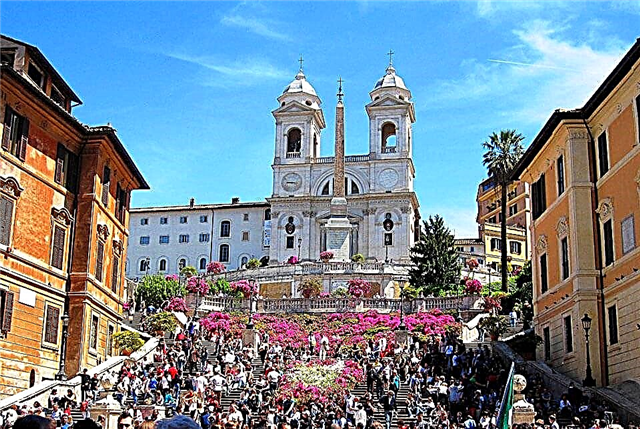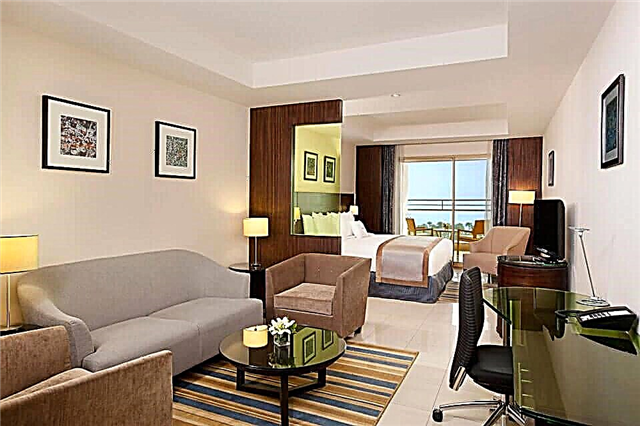Address: Russia, Moscow, Moscow Kremlin
Build date: 1651 year
Coordinates: 55 ° 45'04.6 "N 37 ° 36'51.8" E
Content:
Not far from the Trinity Tower of the Moscow Kremlin, there is one of the unusual palaces. It was erected in the middle of the 17th century by the decree of the Russian Tsar Alexei Mikhailovich. And the palace was intended for the diplomat and boyar Ilya Miloslavsky, who was the father of the tsar's first wife, Maria Miloslavskaya. The dwelling mansions of the tsar's father-in-law look like a fairytale tower. Today it is the only example of the boyar chambers preserved on the territory of the Kremlin.

Palace from the Alexander Garden
The history of the palace
In January 1648, the young Tsar Alexei Mikhailovich married Maria Miloslavskaya. Almost immediately, the construction of a palace for his father-in-law began in the Kremlin. For the chambers, they chose a place next to the Tsar's Palace, where before that there were various outbuildings. The land plot was uncomfortable, elongated, and this determined the architecture of the building. Construction work was completed in 1651, and Miloslavsky was able to enter the new palace.
It is noteworthy that Aleksey Mikhailovich was disrespectful to his new relative and called him "Ilya is not a father-in-law." Tsarist disfavor was determined by the behavior of the Miloslavskys. The ascended clan had a reputation for greedy officials who willingly accepted bribes. The king's father-in-law and his closest relatives did not hesitate to take advantage of the opportunities opened up at court and quickly enriched themselves. At the end of his life in Moscow, "lists of thieves" even began to appear. This was the name of the announcements on the streets of the city, in which Miloslavsky himself and his entourage were mentioned.
Boyarin lived in his mansions for 16 years and died in 1668 at the age of 72. A year later, during childbirth, his daughter and the king's wife, Maria Miloslavskaya, died. After these events, the palace passed into the palace order, and the former boyar chambers were connected by a stone passage with the Tsar's palace.

View of the Amusement Palace and the Church of the Praise of the Virgin
In 1671, Alexei Mikhailovich entered into a second marriage with Natalya Nikolaevna Naryshkina. Soon, in the palace, which began to be called "Amusing", they began to arrange various performances for the king, his family members and those close to him. The Tsar's Amusements were the first theatrical performances in Russia.
The founder of the court theater is considered to have risen under Alexei Mikhailovich Artamon Sergeevich Matveyev. In the history of Russia, he remained as one of the first "Westernizers". Matveyev entered the palace at the age of 12 and was infinitely loyal to the king. He greatly appreciated western novelties and communication with foreigners. Matveyev managed to gather the first troupe of actors who entertained the sovereign, tsarina, princes and princesses. It is known that in the former boyar chambers a ballet performance was staged for the first time, telling a touching story about Orpheus and Eurydice.
The amusements at the court did not last long and ended in 1676, when Tsar Alexei Mikhailovich died of a heart attack at the age of 47. Artamon Matveev fell into disgrace. The Tsar's widow Natalya Naryshkina entered into a confrontation with the Miloslavskys thirsty for power and, together with her son, had to spend a lot of time in Kolomenskoye and Preobrazhenskoye.
In 1679, the queen and her children moved to the Amusement Palace. Before that, the small building was expanded. Peter I disliked Moscow and tried to live in other places. During his reign, the palace housed the Police Order.

The western facade of the palace
At the beginning of the 19th century, the building was reconstructed according to the project of the famous Russian architect Ivan Egotov. The facade overlooking Palace Street was turned into the main one and decorated with fashionable pseudo-Gothic details. In addition, a wing was added to the building for symmetry from the north. After alterations, in 1806 the commandant of Moscow settled in the palace, and his office was placed.
In the 70s of the 19th century, the architect and restorer Nikolai Alexandrovich Shokhin made a lot of efforts to make the palace what it was in the middle of the 17th century. However, the result was only a stylization for the construction of that time.
In 1918, Fanny Kaplan was shot in the garage located in the courtyard of the building, who made an attempt on Lenin's life. Then the families of party and state leaders lived in the palace. In 1932, his wife Nadezhda Alliluyeva was shot in Stalin's apartment. The tragedy took place in one of the rooms, the windows of which are turned towards the Alexander Garden.
Architectural features of the palace
The palace building occupies a small area between the State Kremlin Palace and the Kremlin wall. It was built after the Terem Palace, and therefore the upper tier of the boyar choir looks like a tower. A characteristic feature of the Amusement Palace is the floor-by-floor division of its facades. The floors are separated from each other by expressive white stone carvings. It is believed that both palaces became examples of the first stone residential buildings in Moscow and determined the style that was later copied throughout the city.

Palace from the side of the Trinity Tower
Initially, from the south of the palace there was a front yard and an annex with a front porch, and from the north there was a large utility yard. In addition, the palace building had a passage arch that connected all its parts.
Now the palace has three floors and a deep stone basement. Outbuildings adjoin it on three sides. The main volume perfectly fits the graceful Church of the Praise of the Virgin, built in 1651 simultaneously with the boyar chambers and consecrated as the house church of the Miloslavskys. Gilded domes on thin drums rise noticeably above the buildings and are therefore visible from afar.
On the east side, at the level of the third floor, one can see massive brackets, similar to the mashikuli of medieval fortresses. They are intended to support the church altar, which is located above the living rooms and is traditionally located in the eastern part of the church. To increase the strength of the brackets, the builders inserted white stone blocks into the brickwork.
In earlier times, a flat roof with hanging gardens, made in the western part of the palace, served as a church porch. Then the low fourth floor of the building was completed in its place. The palace also has a turret on four pillars, erected over the refectory church. For a long time it was used as a bell tower and a watchtower.

View of the palace from the Kremlin wall
Palace today
The last large-scale restoration of the old building was carried out in 2000-2004. During the work on cleaning the old plaster, experts discovered a unique white-stone carving of the 17th century on the platbands of the third floor. Skilled craftsmen who worked during the construction of the palace depicted knightly tournaments, flowers, real and fantastic animals and birds. It is noteworthy that the found plots have no analogues in the decor of buildings of the 17th century.
The restorers have tried to restore the original color of the Amusement Palace. At the time of Miloslavsky, the overhanging volume of the house church was painted with expensive red lead, which has a rich red-orange color. The rest of the palace was painted with other, cheaper paints. Today, the main volume of the temple, as in the old days, is painted with red lead, and the details of intricate stone carving are highlighted in white, which makes the building looks very elegant.
Today, the palace houses the services of the Commandant's Office of the Moscow Kremlin, so they are not allowed inside. Tourists visiting the Kremlin are forced to admire the historic building only from a distance. The eastern facade can be viewed from the side of the State Kremlin Palace. And everyone who strolls along the Alexander Garden between the Troitskaya and the Commandant towers can clearly see the western part of the palace.
How to get there
The amusing palace stands between the western part of the Kremlin wall and the State Kremlin Palace. The facade of the building faces the Palace Street.

View of the facade of the palace from Palace Street
The Kremlin is easily reachable on foot from the Aleksandrovsky Sad, Biblioteka imeni Lenin and Borovitskaya metro stations in Moscow. To see the Amusing Palace from the closest possible distance, you need to go through the Alexander Garden and enter the Kremlin through the Trinity Tower. Immediately behind the Trinity Gate, there is a post on the right, which limits the passage of tourists to this part of the Kremlin. From it you can clearly see the bright red and white facade of the palace, located 150 meters from the Trinity Gate.











